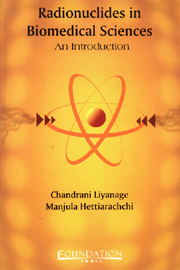Book contents
- Frontmatter
- Contents
- Forewords
- Introduction
- 1 Atomic and Nuclear Structure
- 2 Radiation Detectors
- 3 Units of Radiation Measurements
- 4 Iodine–125
- 5 Radioimmunoassay
- 6 Quality Control in RIA
- 7 Radiolabelled Compounds
- 8 Radiation Safety
- 9 Radiation Protection
- 10 Background Radiation
- 11 Storage
- 12 Contamination
- 13 Radioactive Waste
- References
Introduction
Published online by Cambridge University Press: 26 October 2011
- Frontmatter
- Contents
- Forewords
- Introduction
- 1 Atomic and Nuclear Structure
- 2 Radiation Detectors
- 3 Units of Radiation Measurements
- 4 Iodine–125
- 5 Radioimmunoassay
- 6 Quality Control in RIA
- 7 Radiolabelled Compounds
- 8 Radiation Safety
- 9 Radiation Protection
- 10 Background Radiation
- 11 Storage
- 12 Contamination
- 13 Radioactive Waste
- References
Summary
Nuclear Medicine is concerned with diagnostic and therapeutic uses of artificially produced radioisotopes. In recent years, radioisotope techniques have been used in medicine for a wide variety of diagnostic procedures. Among the many applications of radioisotopes, radioimmunoassay (RIA) has already been established as a versatile and unique procedure. The advantage of this technique is that it does not involve administration of radioisotopes to the patient and so the patient is not exposed to radiation. These assays are useful for the detection and measurement of vitally important biological ingredients such as hormones, vitamins, steroids, drugs etc., thereby enabling early diagnosis of various diseases and better management of treatment.
RIA involves the handling and use of very small quantities of radioisotopes, usually not exceeding 100 micro Curies (3.7 MBq) of iodine-125 and tritium (H). Radiation Protection Regulations promulgated under the Atomic Energy Authority Act of 1969 require authorisation of the user by the Atomic Energy Authority. This is issued to an organisation subject its user satisfying basic safety requirements and having adequate trained staff.
Nuclear medicine procedures are of two types:
In vivo procedures, in which radioisotopes are administered to patients
In vitro procedures, in which radioactivity is added to the samples collected from the patient.
In vivo tests are classified into two:
Imaging procedures
Non-imaging procedures
An imaging procedure, popularly known as scintigraphy, provides an image of the distribution of administered radioactivity in the organ or tissue of interest at any given time. A non-imaging procedure aims to measure gross radioactivity in the organ of interest at any particular time. Serial measurements provide a time-activity curve.
- Type
- Chapter
- Information
- Radionuclides in Biomedical SciencesAn Introduction, pp. 1 - 2Publisher: Foundation BooksPrint publication year: 2008



